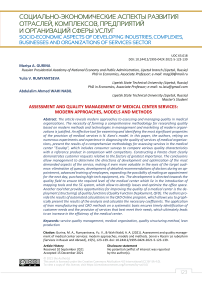Assessment and quality management of medical center services: modern approaches, models and methods
Автор: Gurina Mariya A., Rumyantseva Yulia V., Wahi Nabil Abdulalim Ahmed
Журнал: Сервис в России и за рубежом @service-rusjournal
Рубрика: Социально-экономические аспекты развития отраслей, комплексов, предприятий и организаций сферы услуг
Статья в выпуске: 5 (97), 2021 года.
Бесплатный доступ
The article reveals modern approaches to assessing and managing quality in medical organizations. The necessity of forming a comprehensive methodology for researching quality based on modern methods and technologies in management and marketing of modern organizations is justified. An effective tool for examining and identifying the most significant properties of the provision of medical services is N. Kano's model. In this paper, the authors, relying on numerous experiments and experience in diagnosing the quality of services of medical organizations, present the results of a comprehensive methodology for assessing services in the medical center "Esculap", which includes consumer surveys to compare various quality characteristics with a reference product in comparison with competitors. Constructing a Pareto chart clearly demonstrates customer requests relative to the factors of greatest importance. The conclusions allow management to determine the directions of development and optimization of the most demanded aspects of the service, making it even more valuable in the eyes of the target audience: elimination of queues, development of detailed recommendations of doctors during an appointment, advanced training of employees, expanding the possibility of making an appointment for the next day, purchasing high-tech equipment, etc. The development is directed towards the quality field to ensure the required level of the medical center which lie in the introduction of mapping tools and the 5C system, which allow to identify losses and optimize the office space. Another tool that provides opportunities for improving the quality of a medical center is the deployment (structuring) of quality functions (Quality Function Deployment, QFD). The authors provide the results of automated calculations in the QFD Online program, which allows you to graphically present the results of the analysis and calculate the necessary coefficients. The application of lean manufacturing and QFD methods on a systematic basis ensures timely identification of customer needs and the provision of services that best meet their needs, which ultimately leads to an increase in the efficiency of the medical center.
Service quality management, medical organization, quality structuring method, lean production
Короткий адрес: https://sciup.org/140261929
IDR: 140261929 | УДК: 65.018 | DOI: 10.24412/1995-042X-2021-5-123-139
Текст научной статьи Assessment and quality management of medical center services: modern approaches, models and methods
To view a copy of this license, visit
The study of the issue of ensuring the quality of medical services of commercial structures from the point of view of management and marketing is of a complex interdisciplinary nature, since it is associated not only with satisfying customer requests in accordance with the required functional and legal characteristics of the service itself (technological, legal and economic aspects of the concept of quality), but also affects the quality of life of its recipients, mental and physical health, which undoubtedly goes beyond the presentation of an ordinary "product".
According to the World Health Organization, they are trying to solve the problem of improving the quality of medical care in all countries of the world [3]. This is due to the fact that medical care of inadequate quality is a factor that has a negative impact on both mortality, disability and fertility rates, and the effectiveness of the use of budgetary funds allocated for the development of health care. Thus, given the significant impact on global processes and indicators of the entire society, the problem of the quality of medical services delivery requires serious research, in terms of its assessment and search for ways to improve the efficiency of its provision and management.
In our research, we have repeatedly turned to the study of various aspects of the organizational and managerial mechanism of quality management, including both ideological and methodological issues: diagnostics, quality assessment, application of lean production technologies [5, 11]. However, if our earlier publications dealt with individual tools for assessing and managing the quality of Russian organizations (including medical ones) [3, 4], then within the framework of this work we set the task to generalize a set of tools, the use of which, in our opinion, will allow a systematic approach the study of the quality of service.
The relevance of the research topic is confirmed by numerous scientific publications devoted to the specific features of the paid medical services market, which determine the advantages and disadvantages of paid medicine for consumers [7], the analysis of the implementation of lean manufacturing techniques in the healthcare sector [1]; improving the quality of service delivery in an organization based on a process-oriented approach [8,9]. Dissatisfaction of citizens with public health services creates a steady demand for high-quality analogues provided by the commercial sector. The solvent desire not only to receive treatment, but also to high-quality diagnostics, as well as to maintain and maintain health, is expressed in such an economic term as “medical services demand”; and the totality of various types of medical services provided by the market is disclosed by the economic term "medical services supply". In turn, the satisfaction of the population with medical services depends on the quality of the services provided, the income of the consumers of the service, the technologies used and the level of development of medicine in general.
The problem of ensuring the quality of medical services at the required level touched upon the subject we are analyzing – the medical center "Esculap", which provides its services in the city of Lipetsk.
The purpose of our study was to develop and scientifically substantiate approaches and specific measures to improve the efficiency of the quality of medical services in an organization based on the introduction of QFD technology – a method for structuring quality and tools for lean production.
To achieve this goal, the following tasks were solved during the study:
-
- based on the generalization of theoretical and methodological approaches to the study of service quality in modern organizations, a comprehensive assessment of quality of the services provided by the organization was carried out;
-
- The identified problems allowed us to propose measures for managing the quality of services provided based on the introduction of lean manufacturing technology, as well as the application of the QFD method in the activities of the medical center.
As a hypothesis of the study, we put forward the idea that a comprehensive assessment of the quality of services provided by a medical center, including a combination of various diagnostic methods in the quality management system, allows us to identify the degree of satisfaction of various target audiences with medical services as a whole, its individual aspects, and is a scientific-practical feedback tool which is a condition for improving organizational and managerial relations to ensure the effectiveness of service quality and work of the center.
Insufficient attention to quality diagnostic tools of medical services provided significantly impairs receiving feedback on customer service and reduces the potential for effective work of medical organizations.
The practical significance of the study was proved by the conducted experiments on mapping and introducing the 5C system into the work of the medical center, which proves that the results of the study can be used by similar medical organizations to ensure the quality of services provided and increase their competitiveness in the market.
-
1 Assessment approaches and features of quality management of services in medical organizations
The category of quality of medical services is one of the most ambiguous categories, both in the everyday life of the professional community and among their consumers. Recently, the problem of determining the characteristics and assessing the quality of medical services in an organization is caused by the emergence and intensification of competition in the Russian market, which is associated with the growing interest of the population in high-quality diagnostics and treatment, the level of which does not always correspond to the demands of state institutions. The researchers note that the high competition of commercial medical organizations and the increasing consumer requirements for them increase the importance of creating their competitive advantages. An effective way to increase the competitiveness of medical organizations is the introduction of a system of continuous improvement of the quality of service, adapted to the health care environment in accordance with international standards1.
Quality management in medical organizations is carried out with the aim of continuous improvement of products and services provided. The search for effective methods of quality management creates the preconditions for competitive advantages of a medical organization in the market, increases the flow of customers, forms a positive reputation, and, as a result, leads to an increase in income. Quality management methods provide impact on processes and resources in order to achieve and maintain the required level of quality [6]. In order for the application of service quality management methods to be crowned with success, it is recommended to combine methods and their integrated implementation. One of the key mistakes of most medical institutions in the field of quality regulation is one-time and non-systemic measures to establish feedback, improve the conditions for the provision of services and manage conflicts with consumers. The complexity of diagnostics and the use of various methods of service quality management is a key principle in organizing the work of a medical organization.
Quality assessment of medical care is also an indicator of the effectiveness of the implementation of innovations [10]. Thus, the development of a mechanism for analyzing the quality of medical services is an important and difficult task.
As some authors argue, the quality of medical care (MP) can be characterized and assessed in three areas: a) by structure (material and technical capabilities, human resources, etc., characterize the conditions for the provision of medical care, but are not a guarantee of quality); b) by the result (depends both on the quality of the process of providing medical care, and on factors not related to the work of the doctor, i.e. the severity of the patient, his age, the characteristics of the disease, etc.); c) in the process of providing medical care, i.e. on the medical process (through the influence on the process, you can influence the result) [2].
This approach is very popular and covers three aspects of quality: structure, process and result. Identifying the directions of change in the quality of service should imply the assignment of quantitative values to the quality characteristics. A quantitative assessment of these properties of a medical service involves the formation of indicators of its quality. The assignment of quantitative values to each quality characteristic of a medical service can be carried out using traditional, expert or sociological methods. The directions for assessing the quality characteristics the of medical services can be classified according to the conditions and the medical process and include subjective characteristics (professional, for example, responsiveness, empathy; spatial, for example, external design; claims) and objective (normative, for example, safety, patent protection; meaningful, for example, purpose, effect speed, etc.)
When assessing the quality of any service, various indicators are used, many of which cannot be determined objectively, and in relation to medical services, the use of a scoring system is practiced (the maximum number of points is determined by an expert). The growth of quality indicators of medical services will justify the feasibility of changes, including strategic, innovative ones, in the work of medical institutions, which cannot be dispensed with in the rapidly developing market of medical services.
As part of our previous research, we have repeatedly turned to the experience of using various methods for assessing and ensuring the quality of service on the example of medical organizations, multifunctional centers, food industry enterprises [5, 11]. The collected analytical material allows us to make a conclusion about the feasibility and effectiveness of such modern technologies in the field of quality management as the Noriyaki Kano model, Quality Function Structuring (QFD)
or Quality Function Development (QFD) [12,13]. N. Kano's model acts as an active tool for developing a company's strategy in the field of quality of services provided and solving problems to ensure customer satisfaction and loyalty. The introduction of the SFC method contributes to a deep understanding of consumer needs, which is necessary to provide a high level of service to a medical organization. To the above tools, proven methods of lean production were added, among the variety of which should highlight the mapping of processes aimed at identifying and eliminating losses; the 5C system, which ensures the organization and rationalization of workplaces, an increase in labor productivity, saving time and improving the corporate culture. It is well known that the system does not require significant implementation costs and assumes compliance with simple rules, following which employees of medical centers, from a cleaner to the head of a medical institution, provide conditions for high quality services.
Thus, the most important component of quality management of medical services is the quality of management of the process of providing medical services. At the same time, special attention should be paid to the issues of standardization and flexibility of medical standards, quality assessment and obtaining feedback using various tools, the results of the practical use of which were reflected in our study.
-
2 Comprehensive assessment of the quality of medical services of the diagnostic center "Esculap"
At the moment, the Russian market of paid medicine is represented by two main segments – fully commercial medical centers and municipal institutions. Commercial centers are small private clinics, medical and diagnostic, whose capabilities are limited, and the main emphasis is on a high level of comfort. The second segment is municipal medical institutions that provide paid services.
At the present stage of economic development, the quality and quantity of services provided in public and private medical clinics is increasing. Competition and a pandemic require lower prices, and strict control by insurance companies offering supplementary health insurance services can reduce unnecessary consultations, examinations and diagnostics. In 2021, the situation with the availability of medical care in public clinics will stabilize, which, in the face of a decrease in real incomes of the population, leads to a decrease in the volume of the legal commercial sector in the country by 3.9%, to 194.5 million appointments. In general, under the influence of the pandemic, the commercial medical services market lowered its growth rate by the end of 2020 by 14%, and recovery is possible only by 20222 Patients have become more demanding, Patients have become more demanding, "uberization" is increasingly penetrating medicine, when time saving, the use of digital solutions, and a high level of comfort in receiving services become the main values for the consumer.
The LLC "Medical Diagnostic Center Escu-lap", which we are analyzing, works with both individuals and legal entities. The medical center offers the following categories of services: in the field of medical examinations and medical certificates; in the field of medical services; in the field of diagnostics.
A number of our previous publications have disclosed the advantages of using such a quality assessment tool as N. Kano's model. In order to identify the most significant properties of the provision of medical services, an anonymous survey of 100 respondents using the services of private medical centers was conducted. The answers were double-natured – the response of clients to the presence and absence of the following characteristics of medical services was checked:
-
- high qualification of personnel (diagnostics, treatment);
-
- a wide range of specialists of different profiles;
-
- the politeness of the staff;
-
- use of high-tech equipment;
-
- queues at the reception, to specialists, for
procedures;
-
- location and transport accessibility of the medical center;
-
- work schedule for doctors and clinical laboratory (from early morning to late evening);
-
- make an appointment for the next day;
-
- detailed recommendations, explanations from doctors;
-
- reception by appointment time;
-
- the condition and comfort of the premises (good or bad);
-
- convenient site navigation, electronic recording capabilities.
After processing the primary information for each of the characteristics, a general coordinate system of the properties of medical services was formed for the map of customer satisfaction and dissatisfaction. Figure 1 shows groups of properties, where the X-axis is the presence of a property (dissatisfaction), and the Y-axis is the happiness (satisfaction) of consumers.
From the map of satisfaction of consumers of medical services, one can draw the conclusions presented in Table 1.
Table 1 – Main clusters of properties in accordance with N. Kano's model
|
Features in question: |
Appealing features: |
|
|
|
Features that are not important: |
A must have |
|
-Advantageous location and transport accessibility |
|
Kano's model and its accompanying analysis made it possible to identify areas of development of the medical center in the direction of ensuring the quality of services. With the help of a satisfaction map, we get a better understanding of what customers expect from the center. The findings allow the management to determine the directions of development and optimization of the most demanded aspects of the service, making it even more valuable in the eyes of the target audience: by eliminating queues, developing detailed recommendations of doctors during an appointment, improving the qualifications of employees, expanding the possibility of recording for the next day, purchasing high-tech equipment etc.
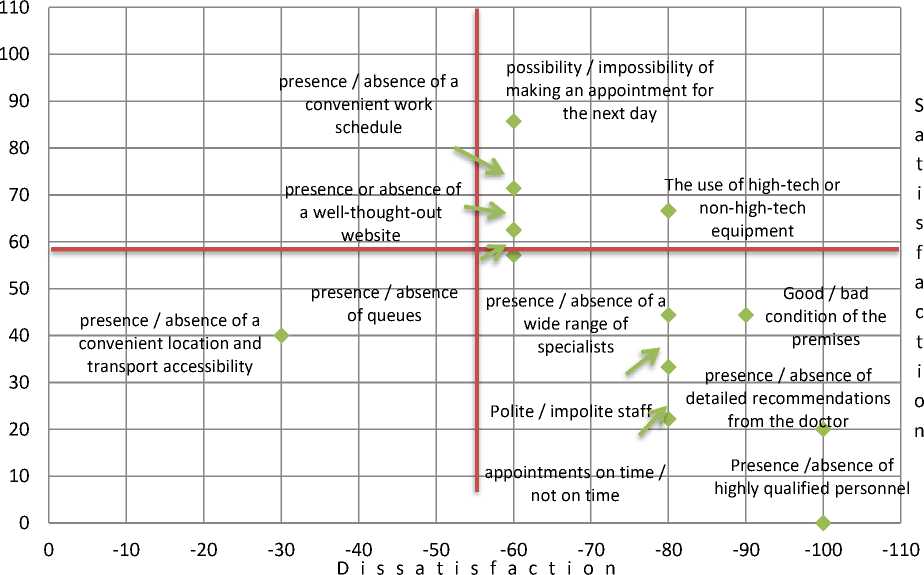
Fig. 1 – Map of satisfaction and dissatisfaction consumers of medical services
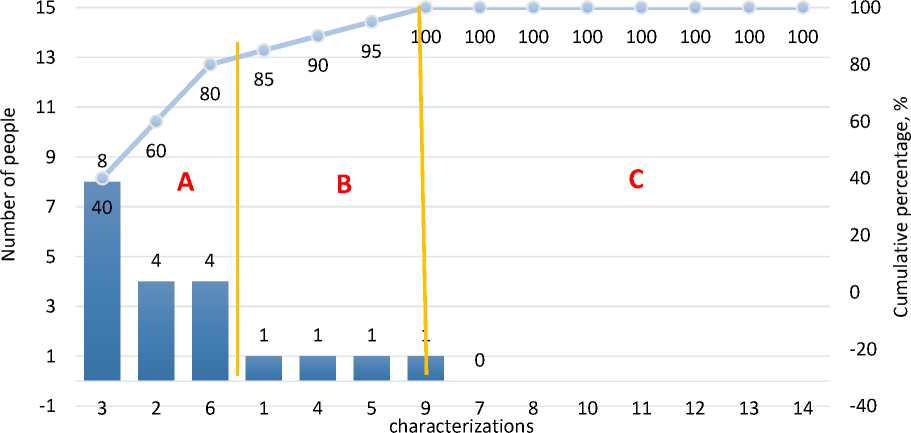
Fig. 2 – Pareto diagram, Lorentz curve and ABC analysis of the characteristics of the quality of service delivery in medical centers
The study of quality management of service delivery can be based on various assessment methods. We used a methodology for assessing a complex indicator of the quality of medical services, built on the data of a survey of 100 respondents on 14 single quality parameters.
The study involved three medical centers: "Esculap", "Alternative" and "Treatment and
Diagnostic Center", located in Lipetsk. On the basis of the proposed list of characteristics of the quality of the provision of medical services, the respondents selected the properties of the reference medical center and carried out a comparative analysis of competitors with the reference. The results of the comprehensive assessment are shown in Table 2.
Table 2 – Comprehensive assessment of proximity to the reference center
|
Medical center characteristics |
«Esculap» |
«Alternativа» |
«Treatment and Diagnostic Center No. 1» |
|
1. Practice oriented |
0,53 |
0,47 |
0,93 |
|
2. Qualification level of doctors |
0,88 |
0,75 |
0,69 |
|
3. Material-technical base |
0,83 |
0,83 |
0,89 |
|
4. Appointment times with doctors and in the clinical laboratory |
0,94 |
0,88 |
0,94 |
|
5. Location and transport accessibility |
0,91 |
0,85 |
0,79 |
|
6. Reputation of the medical center |
0,57 |
0,93 |
0,88 |
|
7. Staff, quality of service |
0,93 |
0,93 |
0,87 |
|
8. Information about certificates, diplomas, achievements |
0,82 |
0,85 |
0,92 |
|
9. Efficiency (speed) of service provision |
0,89 |
0,89 |
0,83 |
|
10. Information availability about a private clinic or medical company on the website and in social networks |
0,88 |
0,93 |
0,57 |
|
11. Patient-doctor communication |
0,85 |
0,8 |
0,75 |
|
12. Interior, furnishing conditions |
0,75 |
0,69 |
0,94 |
|
13. Service promotion (discounts and promotions) |
0,87 |
0,69 |
0,85 |
|
14. Free additional pleasant things while waiting for a consultation or a medical procedure |
0,93 |
0,87 |
0,81 |
|
Comprehensive assessment |
0,806 |
0,823 |
0,845 |
To assess the degree of expert agreement, we used the concordance coefficient, which was 0.78. It is high enough for the study to be considered meaningful and credible.
The next step in a comprehensive assessment of the quality of medical services of the center under consideration was the construction of a Pareto diagram and ABC analysis of the characteristics of the medical center (Fig. 2).
One third of all identified reasons – group A includes 2, 3 and 6 characteristics – has an 80% impact on the quality of service. In accordance with the Pareto Rule, it is necessary to strengthen the control of these factors. The provision of high-quality medical services is impossible without a good material-technical base – equipping medical offices with high-tech equipment. The level of qualification of doctors is also important – a doctor must be competent and have a higher professional education. A doctorate in medical sciences, additional education of medical personnel or retraining in the field of medicine are significant characteristics of the quality of the service. It should be noted that the positive reputation of the medical center is also a sign of the quality of services for the consumer. Therefore, positive reviews about the organization play a significant role in choosing a medical center.
Analyzing the results of a comparative assessment of the quality of work of the medical center under consideration and competitors, the following conclusions can be drawn.
Firstly, the medical centers considered in the framework of the comparative analysis have a relatively high level of doctors' qualifications, quality of service, are sufficiently equipped with the necessary equipment and are characterized by high efficiency in the provision of services, which largely determines a fairly high level of competition between them.
Secondly, the weak link among the assessed characteristics of these medical centers is the positioning of services, that is, the inability to highlight truly competitive advantages and focus your marketing around them. In conclusion, it should be said that the analysis of competitors must be carried out regularly, at least once every six months, and constantly monitor the emergence of new players, any advertising activity, promotions, and expansion of the assortment. With those competitors that are indirect, it is possible to establish cooperation, which will give an advantage over stronger market participants.
-
3 Measures to introduce lean manufacturing to improve the efficiency of quality management of medical services
To improve the efficiency of service quality management, we will use the tools of lean manufacturing (LM). The implementation of the LM must begin with the creation of a lean center project, the strategic objective of which is to improve the efficiency of quality management of the services provided by a medical organization.
As an example, consider a project option to optimize the process of visiting a narrow specialist in a medical center.
Project – "Optimization of the organization of patient flows when visiting a narrow specialist on the example of a cardiologist." Objectives of the project:
-
- reducing the waiting time in the queue;
-
- satisfaction of patients and healthcare professionals with the organization of the appointment process.
Table 3 presents the problems that can be solved at the initial stage of optimizing the work of a given medical center, as well as suggestions for solving these problems.
The basic stage of preparation for the implementation of the project is the mapping of the processes of the medical center. It allows you to visualize and analyze the movement of people and objects along the value stream, see losses in work and identify existing problems [8]. Flow mapping is carried out in two stages: 1) building a map of the current state (collecting information at the site of the workflow) (Fig. 3); 2) building a map of the target state (Fig. 4).
Table 3 – Proposals for optimizing the provision of services at MDCE
|
Problem |
Reasons |
Solutions |
|
Queue at the reception |
|
|
|
Time spent on finding the right office |
|
|
|
Periodic queues at the offices |
- Uneven flow of citizens |
- Assigning an administrator function to the registrar |
|
Duplication of examinations of specialists before and after laboratory tests |
- Inefficient routing scheme |
- Development of a new routing scheme |
Medical Center Entrance

Personal identification by passport, survey (2-3 min.)
Queue at the registry (5-20 min.)
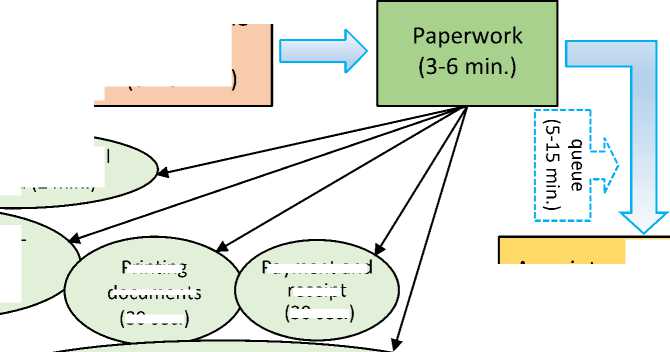
Printing documents
(30 sec.)
Payment and receipt
(30 sec.)
5 sec.

Formation of a medical record card (2 min.)
Appointment with a cardiologist
(8 min. – 9,5 min.)


Personal identification, survey (1 min.)

Passport info database input (2 min.)
Issuance of a set of documents, referral to the required office (1 min.)

ECG (2-3 min.)
Preparation, taking off clothes to the waist (1 min. 30 sec. – 2 min.)
Fig. 3 – Map of the current state of the process "visiting a cardiologist"

The patient gets dressed. Marking in documents (1 min. 30 sec)

With the help of a map of the current state queues at the reception and at doctors' offices, as of the process, we were able to identify the main well as the execution of unnecessary paper docu- losses in its implementation. These include: long mentation.
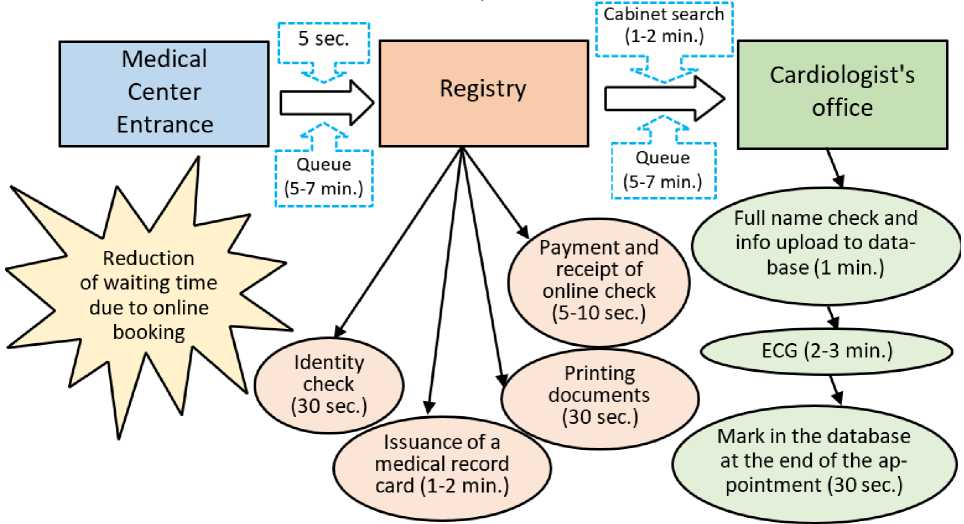
ECG (2-3 min.)
Queue (5-7 min.)
Mark in the database at the end of the appointment (30 sec.)
Issuance of a medical record card (1-2 min.)
Identity check (30 sec.)
Payment and receipt of online check (5-10 sec.)
Printing documents (30 sec.)
Full name check and info upload to database (1 min.)
Reduction of waiting time due to online booking
5 sec.
Cabinet search (1-2 min.)
Queue (5-7 min.)
Cardiologist's office
Registry
Medical Center Entrance
Fig. 4 – Map of the target state of the process "visit cardiologist"
The time of the process in the current state was from 23 min. 5 sec. up to 52 min. 35 sec., And the time spent on receiving the service in the target state, when the losses will be eliminated, can be from 17 minutes. 5 sec to 23 min. 45 seconds, which means that there will be time savings for both the patient and the staff of the medical center.
Comparison of the two states of the processes – current and target – makes it possible to form a set of actions and measures for the transition from one to another. To optimize the organization of patient flows and eliminate losses, we have developed measures presented in Table 4.
Table 4 – Optimization of patient flow organization
|
Problem |
Measure |
Period |
|
Divide flows |
||
|
tn ‘ьо о го с .9 о ГО "О ~ О ” — £ о С с го <и о „с 4-. (1) > ™О С 5~ = О ГО |
The Sick
Professional examinations
Re-recording
|
со го го го м о м |
|
Electronic registration |
||
|
CD || ГО (D > и ГО ^ §2 |
IP telephony
|
со го го го м о |
|
О а5 ЬО О о ио С с § i о о § 'ьо ^ _____________1 |
- Popularization of the possibility of making an appointment with a doctor through the website |
п о QJ |
To ensure the implementation of the lean center project, it is advisable to use such a method as building a 5C system. As a result of the successful implementation of the system, working conditions are improved, and the amount of financial losses is reduced.
To find the optimal option for placing objects inside the office, several approaches are being tested, in which an experiment is carried out on the movement of people, the location of cabinets, chairs, bedside tables and the one that is most convenient for movement and access to items of use is selected.
The next step is to keep the workplace clean and standardize. Maintaining a clean workplace is achieved by minimizing the items needed for work and placing them in a certain order in production cabinets. In this case, the doctor or nurse quickly finds the required items, while reducing the time for performing certain actions, there is an economy that leads to an increase in bandwidth when serving a large number of clients.
Based on the results of space optimization and placement of household items, we obtain a new format of the doctor's office, which is shown in Figure 5 below. on work tables and cabinets, convenient location for patients.
And the final step is to improve order and discipline. At this stage, the content in the folders has been structured, the folders have been signed, the correct order has been determined and standardized.
In order to preserve the results obtained, it is necessary to train employees in the interim standard and conduct 5C audits at regular intervals. Table 5 shows a fragment of the checklist form for determining the conformity of the workplace of the medical center according to the 5C system.
Thus, the introduction of lean manufacturing tools in the activities of the medical center "Es-culap" allowed to optimize the work of individual divisions of the organization. The basis for the implementation of a lean manufacturing project was the mapping of individual processes, for example, such as a visit to a narrow specialist. Also, the use of the 5C system made it possible to significantly optimize the office space and improve the efficiency of quality management of the provision of services at MDCE LLC.

|
Было / стало |
Before / After |
|
Шкаф для одежды |
Wardrobe |
|
Кушетка |
Couch |
|
Стол |
Desk |
|
Стул |
Chair |
|
шкаф |
Cupboard |
|
Раковинна |
Sink |
|
Ширма |
Folding screen |
|
тумба |
Side table |
Fig. 5 – Doctor's workplace after changes
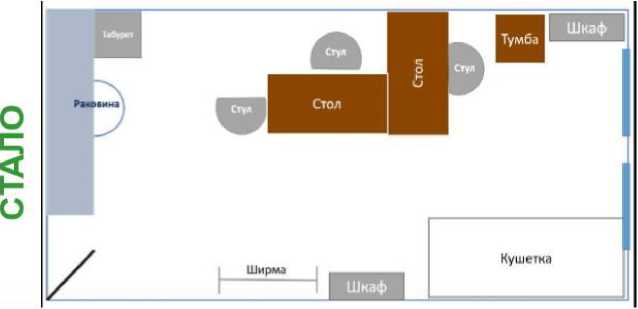
Table 5 – Fragment of the checklist for assessing the conformity of the workplace to the 5C system for a medical organization
|
Step 1 sorting |
Office |
|
|
Criterion |
Evaluation (0 – no, 1 – yes) |
Comment |
|
Work space (office) as a whole |
||
|
No unused furniture |
||
|
All office equip- is working ment (printer, properly |
||
|
scanner etc.) is used |
||
|
No extra cables |
||
|
There are no unnecessary personal items (non-seasonal items excessive amounts of dishes etc.) |
||
|
There is no excessive placement on the walls of the office (paintings, photos, certificates, testimonies, letters of gratitude) |
||
|
Desktop |
||
|
working Items on the properly |
||
|
desktop are in use |
||
|
The equipment working |
||
|
on the desktop is use |
||
-
4 Improving the efficiency of the quality of medical services based on the QFD method
Ensuring the level of quality in the provision of medical services requires systematic work in the field of comparing the characteristics set by the internal standards with the required clients. In our early publications, we provided evidence of the effectiveness of using such a quality management tool as a method of deploying (structuring) Quality Function Deployment (QFD) on the example of organizations in other areas of activity [3, 11]. In this publication, we would like to provide a rationale for the feasibility of this technology in the activities of the medical center.
To build quality in the study, we used the QFD Online program, which allows you to graphically present the analysis results and calculate the necessary coefficients.
The first major step will be to identify customer requirements. The importance of this stage is primarily due to the fact that the competitiveness and profitability of the medical center as a whole depends on the client's satisfaction.
We used surveys, complaints and positive reviews from consumers, contact personnel, market research reports, industry reports, and competitor data as sources of information about consumer requirements. The main requirements of clients include: a) convenient location of the center; b) convenient work schedule; c) the attentiveness of the staff; d) equipment of offices (material-technical base); e) a wide range of services; f) high quality of services provided; g) efficiency in the provision of services; h) no queues; i) ease of recording to the center; j) the reputation of the medical center. Requirements are presented on the left-hand side of the "home of quality" (column "Consumer requirements").
On the second stage of building a "house of quality", the ranking of consumer requirements is carried out. The data is entered in the column "Weight, importance". The maximum score – 5 points – received the following characteristics: "Wide range of services" and "High quality of services provided." “Convenient work schedule”, “Equipment of offices (material and technical base)”, “Efficiency of service provision”, “No queues”, “Ease of registration at the center” and location of the center" and "Attentiveness of the staff" scored 3 points of significance, because they are the features of a premium segment rather than a mass one.
The third stage of our research – on the basis of an expert survey, we have formed a list of functional requirements. These are such areas of improving the quality of service as: parking; proximity to transport stops; work schedule and hours; the level of professional training and culture of service; high-tech and modern equipment; licensing of all types of activities; own clinical laboratory; reviews of visitors; registration through the website, by phone; fast navigation and rich website content; a sufficient number of employees; posting information about the merits of employees; analysis of prices and services of competitors; analysis of the needs of regular customers; advertising companies. The list of these requirements is presented in the line "Functional requirements".
The fourth step is to determine the correlation between customer and functional requirements. Certain graphic symbols have been devel-
“Reputation of the medical center” are also im- oped to indicate the types of communication in portant – they received 4 points. "Convenient the program (Fig. 6).
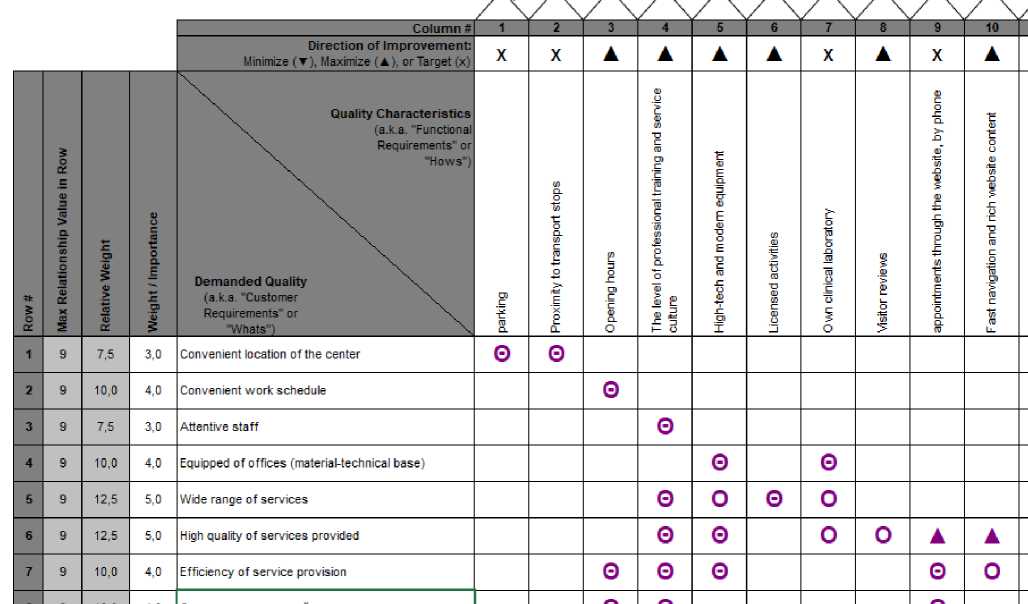
Fig. 6 – Fragment of the "house of quality" – a matrix of communication for the medical center "Esculap"
Next, we introduce into the program the columns describing the competitive environment – these are the LLC "Medical Center Esculap" we are considering and the 5 strongest competitors in the provision of medical services: Alternative, Treatment and Diagnostic Center No. 1, Family Doctor, Health of the Nation, Be Healthy. We have given points for the quality characteristics of customer service in the range of 0-5 points. So, for example, Treatment and Diagnostic Center No. 1 has the strongest positions in terms of convenient location of the center, equipment of offices, high quality of services, but other characteristics are either on a par with competitors, or inferior to them. The weakest position in the quality of services is taken by the “Health of the Nation” medical center.
The characteristics that have received the greatest positive correlations with others are a) high-tech and modern equipment; b) Licensing of all types of activities; c) reviews of visitors; d) the level of professional training and culture of service. A positive change in these factors causes positive changes in most others. Therefore, the management of the center needs to pay attention to them if they want to improve the quality of the services provided. At the same time, there are characteristics, the change of which has the opposite effect, for example, such a relationship is observed between the work schedule and the manufacturability of the equipment. Because with a high level of equipment, customers are willing to sacrifice their free time and put up with the inconvenience of working hours. The same negative correlation is between working hours and the availability of laboratories and licensing of all activities.
As a result, in quantitative terms, the highest values were obtained for such required characteristics as a qualified staff of specialists, a client receiving high-tech assistance, visiting the center at a convenient time and identifying the demand for services. The last functional characteristic is proof of the need for feedback and the development of an effective marketing policy for the center. The same parameters are also the most difficult in ensuring the work of the center "Escu-lap". But their implementation creates the core competencies of the institution in comparison with competitors. The least value are certificates, diplomas and gratitude, as well as convenient access to the center. If Esculap is able to identify the needs of its customers in a timely manner and constantly work to maintain the qualifications of its employees, provided it has a high-tech base, it will automatically provide its customers with a higher quality service.
A general view of the application of QFD to the study of the quality of service at the Esculap Medical Center is shown in Figure 7.
Summing up our research, it should be said that among the wide variety of technologies used in the assessment of service organizations, not enough attention is paid to the N. Kano model we have considered, the technology of complex assessment and the method of structuring quality. Despite their academic nature, the methods are quite accessible for the development of marketing services of medical organizations. The use of the quality tools we propose to use in their totality allows us to significantly reduce the time for the provision of services, improve the conditions for finding clients in the medical center, and increase their interest. The use of lean manufacturing and QFD methods on a systematic basis ensures timely identification of customer needs and the offer of services that best meet their needs, which ultimately leads to an increase in the efficiency of the medical center.
Conclusion
The problems of quality management in modern medical organizations are associated, among other things, with the issues of choosing a research methodology for the characteristics of a service that are significant from the consumer's point of view, as well as the possibility of introducing modern lean technologies in customer service. In this work, we tried to summarize effective, in our opinion, models and methods that are quite applicable in the practice of medical centers.
In the course of the study, approaches and specific measures were developed and scientifi-
ЖУРНАЛ
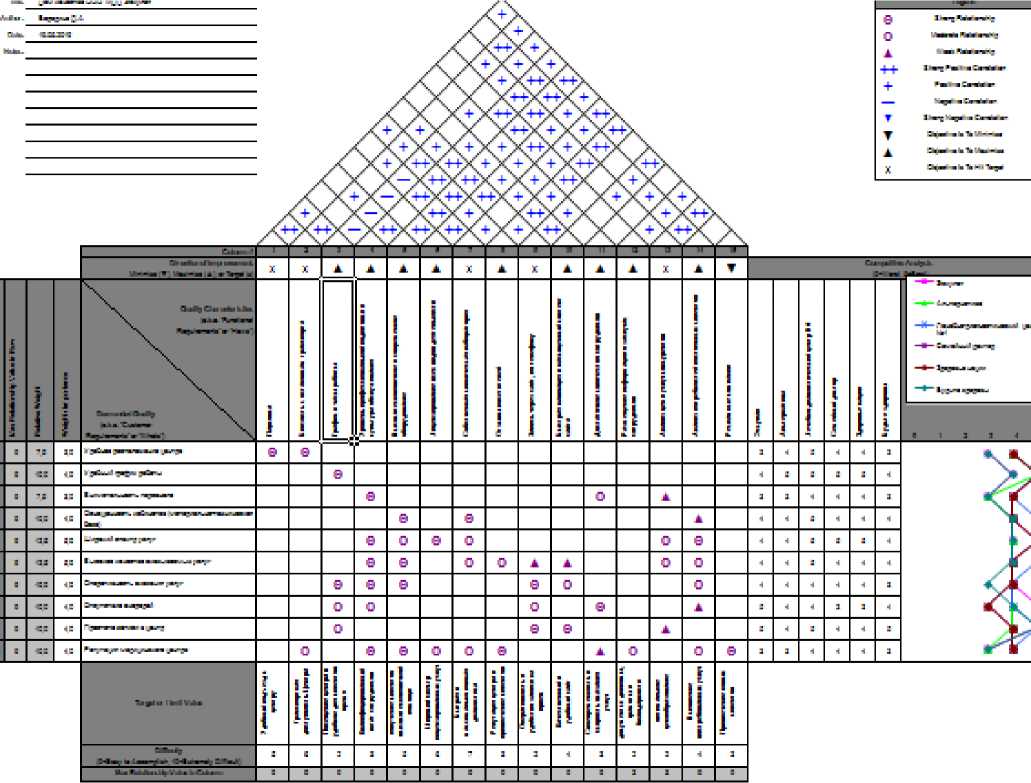
Fig. 7 – General view of the "house of quality" for the provision of medical services of the center "Esculap"
cally substantiated to improve the efficiency of quality management of medical services by LLC "Medical Diagnostic Center Esculap" on the basis of a comprehensive assessment and application of N. Kano's model.
We paid attention in detail to the presentation of the content of N. Kano's model, the method of structuring quality and integrated assessment in our earlier works, including the necessity and effectiveness of using lean technologies in the activities of medical organizations [3, 4]. In this study, we tried to summarize the main approaches to the study of the quality of services on the example of a specific medical organization, formed indicators of their assessment, considered methods and features of quality management of medical services in practice. All this made it possible to form an understanding of the need for an integrated approach to the study of the subject of research.
Based on the use of N. Kano's model and a survey of satisfaction with the quality of services provided by the medical center, a map of customer preferences was formed, which revealed those features of medical services that are most attractive to consumers and require further analysis by the management: no queues, a well-developed website, convenient work schedule, high-tech equipment. With the help of a comprehensive assessment of the services provided, we supplemented the study with a rating of the importance of properties for the consumer, which allows the management of the medical center to respond not to all problems in the same way, but according to the importance for clients, which was confirmed in the construction of a Pareto chart. The results of the study are presented in comparison with the assessment of the quality of
СЕРВИС
В РОССИИ
И ЗА РУБЕЖОМ services of the main competitors, which allows you to see your strengths and weaknesses.
We proposed measures to manage the quality of services provided based on the introduction of lean manufacturing technology into the activities of a medical center, and specifically such tools as mapping and 5C systems. It is worth noting that the use of these tools in practice made it possible to optimize the work of individual divisions of the organization, to reduce the time spent on the main processes for providing services.
To develop proposals for improving the quality of service, we used a method of quality management and analysis, which can also be used in the service sector – this is the deployment of the quality function (structuring the quality function, Quality Function Deployment, QFD).
According to the survey results, functional solutions such as qualified staff, high-tech assistance and visits to the center at a convenient time for the client are most important for customer satisfaction. If LLC MDCE will timely identify the needs of its customers and constantly work to maintain the qualifications of its employees, provided it has a high-tech base, it will automatically provide its customers with a higher quality service.
The study showed that service quality management can become not only a chance for organizations to survive, but also gain new positions, successfully develop and adapt to the challenges of the external environment, a chance to be competitive, modern and in demand.
The results obtained demonstrate the possibilities of an integrated approach in the study and management of the quality of services provided by a medical organization. In the case of acquiring certain skills in the annual comprehensive assessment using the above methodology, N. Kano's model, as well as carrying out periodic calculations using the quality structuring method, the management receives a ready-made quality management system in their organization, constant feedback, work with which will provide competitive advantages in regional market and stable marketing positions.
Список литературы Assessment and quality management of medical center services: modern approaches, models and methods
- Gorodkova, S. A., & Taskina, E. B. (2019). Features of management decisions in the healthcare system based on the principles of lean production. Bulletin of the Trans-Baikal State University, 25(5), 105-113 (In Russ.).
- Golyshev, A. Ya., & Nosyreva, O. M. (2011). The concept of creating a quality management system in medical and preventive institutions. Medical conferences [Electronic journal]. URL: http://www.medico.ru/articles/management/article_001.htm (Accessed on: 10.05.2021). (In Russ.).
- Gurina, M. A. (2019). Process-oriented thinking: the role of the method of structuring quality functions in the Kaizen system. The global transformation of Russia in the era of digitalization: problems, features, trends: Materials of the XIII scientific and practical international conference, 15-21. (In Russ.).
- Gurina, M. A. (2017). Creation of an effective quality management system in medical organizations based on the introduction of "lean" production technology. Bulletin of the Voronezh State University of Engineering Technologies, 79(4/74), 378-384. (In Russ.).
- Gurina, M. A., & Rumyantseva, Yu. V. (2018). Managing the competitiveness of goods based on the application of the theory of attractive quality of N. Kano (on the example of JSC "Sagunovsky meat processing plant"). Bulletin of Voronezh State University of Engineering Technologies, 80(4/78), 426-435. (In Russ.).
- Efimov, V. V. (2016). Means and methods of quality management. Moscow: KnoRus. (In Russ.).
- Zyukin, D. A., Belyaev, S. A., Vlasova, O. V., Najafova, M. N., Reprintseva, E. V., & Sergeeva, N. M. (2019). On the trends in the expansion of the paid medicine market in the federal districts of the Russian Federation. Bulletin of the NGIEI, 3(94), 62-73. (In Russ.).
- Rother, M., & Schuck, J. (2015). Learn to see business processes. Building maps of value creation flows. Moscow: Alpina Publisher LLC, (In Russ.).
- Shilkina, A. T., Tyasto, S. A., Yaskin, A. N., & Pashkova, A. A. (2021). Improving the quality of service provision in an organization based on a process-oriented approach. Quality. Innovations. Education, 1(171), 28-36. (In Russ.).
- Shein, A. F. (2011). Analysis of the effectiveness of innovative activities in medical and preventive institutions of services. Social aspects of public health, 17(1). URL: http://vestnik.med-net.ru/content/view/274/30/lang.ru (Assessed on: 13.04.2021). (In Russ.).
- Gurina, M. A., Moiseev, A. D., Rumyantseva, Yu. V., & Shurupova, A. S. (2021) Improving the quality and accessibility of public services of multifunctional centers based on lean production. International Transactional Journal of Engineering, Management and Applied Sciences and Technologies, 12(4), 1-11.
- Miwno, Sh., & Akao, Y. (Eds.) (1994) QFD. A Customer-Oriented Approach to Quality Planning and Deployment. Tokyo, Japan: Asian Organization for Productivity Improvement.
- Lillrank, P., & Kano, N. (1989). Continuous improvement: Quality control circles in the Japanese industry. Michigan Papers on Japanese Studies, 19. Ann Arbor: Center for Japanese Studies, University of Michigan, XVI.

